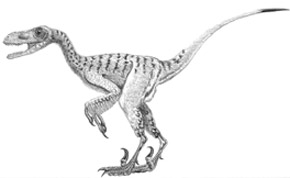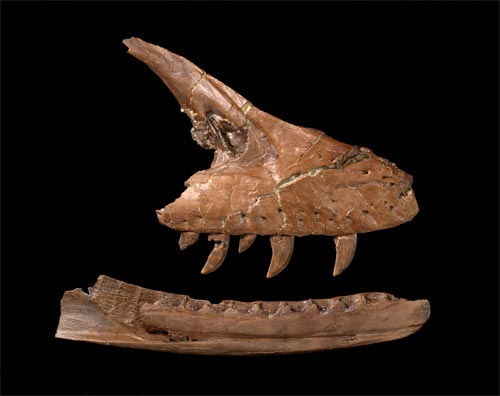New North American “Raptor” Described
New North American Dromaeosaurid with Affinities to Asia’s Velociraptor
A team of scientists from the Royal Ontario Museum (Canada) working in collaboration with a number of other Canadian palaeontologists have announced the discovery of a new type of dromaeosaur from the Hell Creek Formation of Montana (United States). The dromaeosaurs are fast running, relatively small, carnivorous dinosaurs that flourished during the Cretaceous period. This new genus, known from fossilised teeth as well as upper jaw material (maxilla) and lower jaws (dentary), lived at the same time as Triceratops and Tyrannosaurus rex.
North American Dromaeosaurid
The fossils represent the latest dromaeosaurid known from North America (Maastrichtian faunal stage) and a phylogenetic analysis reveals that this dinosaur is perhaps more closely related to Late Cretaceous Asian “raptors” such as Velociraptor (V. mongoliensis) and Tsaagan (T. mangas) rather than to North American dromaeosaurs that lived in the Campanian faunal stage.
An Illustration of a Typical Feathered Dromaeosaurid Dinosaur
Picture dredit: Everything Dinosaur
Acheroraptor temertyorum
This new predator has been named Acheroraptor temertyorum. It was most probably feathered and around 2.5 to 3 metres in length, perhaps weighing as much as forty kilogrammes. It probably hunted small mammals, birds, lizards and other small animals whilst avoiding the attentions of the much larger apex predators the Tyrannosaurs. It may also have scavenged the kills of T. rex. Acheroraptor (pronounced Ack-ear-oh-rap-tor) means “Acheron Robber or Plunderer”, the genus name being derived from Acheron, the River of Pain in the underworld of ancient Greek mythology, along with the Latin word “raptor” – plunderer or robber.
The species name honours James and Louise Temerty who have financially supported the palaeontology department of the Royal Ontario Museum. A detailed paper outlining the new discovery, and the implications for the Hell Creek Formation and its fauna, has been published in the scientific journal Naturwissenschaften.
Hell Creek Formation
The size of the jaws plus the isolated teeth found in the Hell Creek Formation in the past, indicate that Acheroraptor was relatively large for a Late Cretaceous dromaeosaur. It was certainly bigger than the better known, and perhaps more famous Velociraptor (which was about the size of a turkey).
Lead Author of the study, Dr David Evans, Curator of Vertebrate Palaeontology at the Royal Ontario Museum commented:
“Acheroraptor gives us a more complete picture of the ecosystem in North America just before the great extinction that marked the end of the Age of Dinosaurs. The close evolutionary relationship of Acheroraptor to a small group of late-occurring Asian species that includes Velociraptor suggests migration from Asia continued to shape North American dinosaur communities right up until the end of the Cretaceous period.”
It had long been suspected that dromaeosaurs existed alongside the likes of Triceratops and Tyrannosaurus rex but apart from numerous isolated teeth, there was no definitive proof of their existence until this new fossil material was prepared and described.
The Maxilla and Dentary of A. temertyorum
Picture credit: Royal Ontario Museum
To view an articulated model of Acheroraptor (whilst stocks last): Beasts of the Mesozoic Articulated Dinosaur Models.
Professor Phil Currie, an expert on the dromaeosaurids found in the older Dinosaur Park Formation of Alberta, Canada (Campanian faunal stage), stated:
“We have had scanty evidence for more than a century that “raptors” lived with Tyrannosaurus rex until the end of the Cretaceous, but the absence of clearly identifiable dromaeosaurid fossils has been perplexing to the dinosaur hunters who have worked in the Hell Creek area, which has otherwise produced abundant fossils.”
Large Teeth
The strongly curved, quite large teeth with distinctive serrations (denticles) had been known from the Hell Creek Formation for many decades, but in the absence of fossil bones, researchers did not have the material available to help them to understand the evolutionary relationships between this Late Cretaceous dromaeosaur and other members of the Dromaeosauridae from the Northern Hemisphere until now.
Studies of more abundant fossil material from Asia suggests that Acheroraptor, which roamed North America around 67-66 million years ago is more closely related to the long-snouted Velociraptorines of Asia than it is to earlier North American dromaeosaurids. This suggests that even very late in the Cretaceous there was extensive migration and mixing of different species from Asia and North America.
Discussing the new dinosaur, Derek Larson, a PhD student at the University of Toronto, who studies under Dr Evans said:
The most exciting aspect of the specimen is the teeth. We now know that those teeth all belong to the same animal and we now know enough about what that animal looks like to distinguish it as its own species.”
Analysis of Acheroraptor’s teeth in the context of a larger sample of small meat-eating dinosaur teeth suggests a decline in dromaeosaur diversity in North America just before the end-Cretaceous extinction event.
It is important to distinguish Acheroraptor from “Archaeoraptor”, the generic name given to a composite fossil that was at the centre of a scandal a few years ago. A fossil found in China had an article published in National Geographic magazine which claimed this was a transitional, “missing link” between birds and fast-running theropod dinosaurs. Prior to the article being published in this prestigious publication, doubts had been raised about this fossil, as it seemed to show a long-tailed dinosaur with feathers and wings.
Phil Currie was one of the scientists asked to examine the fossil material and this specimen was eventually proved to be a forgery. It was actually a clever composite made up of several fossils skilfully glued together. The tail was later identified as belonging to Microraptor spp. but the legs, feet and toes belonged to an entirely different creature, very probably a prehistoric bird. The Archaeoraptor scandal, a fossil forgery that fooled a number of leading scientists highlighted the illegal fossil deals that take place in some parts of the world.
As a result of this scandal, one that ended in humiliation for a number of academics and for the National Geographic magazine, there have been calls for much more scientific scrutiny of vertebrate fossils.



